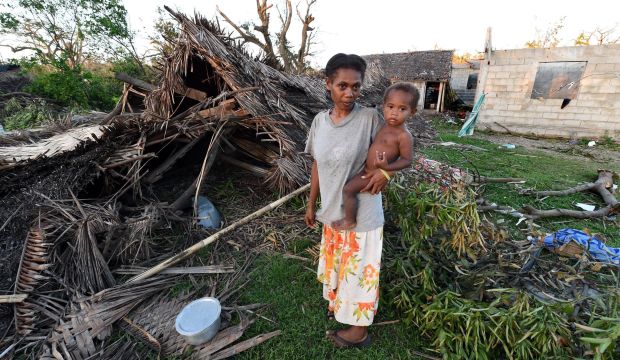
Lana Silona prepares food with her son Costello in front of their ruined home on the island of Tanna, Vanuatu, on March 17, 2015. (EPA/Dave Hunt)
Port Vila, Reuters—International aid agencies ramped up appeals for cyclone-hit Vanuatu on Wednesday, warning that the powerful storm that affected more than two-thirds of the South Pacific island nation had wiped out crops and destroyed fishing fleets, raising the risk of hunger and disease.
Residents of the southern island of Tanna said food and basic supplies were running low, while relief workers were still battling to reach many islands pummeled by Cyclone Pam’s gusts of more than 185 mph (300 kph) on Friday and Saturday.
The United Nations said the official death toll was 11, but many officials anticipate that number will rise once they are able to more thoroughly inspect the outer islands of the scattered archipelago.
Sweden said on Tuesday that a Swedish man aged around 80 who had emigrated was among the dead.
Sune Gudnitz, Pacific head of the UN Office for the Coordination of Humanitarian Affairs, said getting food supplies to isolated communities was a concern. “The challenge of getting things out, whether it’s people or goods, remains. We want to avoid creating a bottleneck in [Vanuatu capital] Port Vila, so we very quickly need to work out a plan for getting things out,” Gudnitz said.
Two C130 aircraft carrying vehicles, engineers and emergency supplies could be seen preparing to depart from Port Vila airport for outer islands on Wednesday.
The UN’s World Food Programme said it was working with aid agencies on the ground to help distribute food and other aid after banana, coconut and other crops were destroyed, livestock killed and boats and fishing canoes wrecked.
The UN Children’s Fund (UNICEF) said the government was kicking off a measles prevention campaign because of low immunization rates and a recent outbreak.
Tourism, which accounts for about 40 percent of Vanuatu’s economy, has also been badly affected, with Port Vila closed to cruise liners indefinitely.
With communications cut off and reconnaissance flights revealing destroyed houses, shredded forests and damaged buildings, aid agencies had been particularly worried about Tanna, which bore the full force of the storm.
On Tuesday, a Reuters reporter on the island of 29,000 people, about 125 miles (200 kilometers) south of the capital, said that while damage was extensive, it appeared most of the population had survived by sheltering in schools, churches and other sturdy buildings.
“People sheltered in school buildings. We were helping one another,” Ropate Vuso, 67, told Reuters in Tanna township.
“We are running short of food, water, shelter and electricity. We have no communications, we are still waiting for the people from parliament, the chief and the president, but still nobody is coming.”
There were reports of five deaths in and around the main town of Tanna.
Hanna Butler from the New Zealand Red Cross said residents would require long-term help.
“They live off their garden, and it will take months to recover to grow enough food,” Butler told Reuters.
Butler visited the neighboring island of Futuna on Wednesday and said it appeared to have escaped significant damage.
Near Port Vila, shopkeeper Diana Varu, 40, survived by running from house to house as winds tore the roofs off, finally sheltering with her two children and 16 others in a neighbor’s home.
“I’ve never seen a storm like that. My nine-year old boy Sam panicked and cried,” she said.
Formerly known as the New Hebrides, Vanuatu, one of the world’s poorest nations, is a sprawling cluster of more than 80 islands and 260,000 people, 1,250 miles (2,000 kilometers) northeast of the Australian city of Brisbane.
Perched on the geologically active “Ring of Fire,” it suffers from frequent earthquakes and tsunamis and has several active volcanoes, in addition to threats from storms and rising sea levels.
